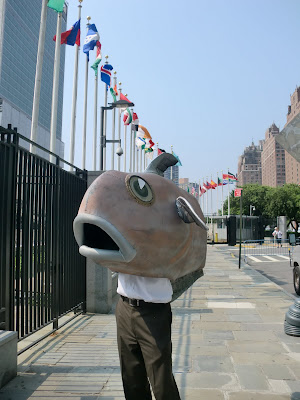Why did we choose the Roundnose Grenadier over so many other species for our campaign? The choice was clear for a few reasons.
The Roundnose is now endangered as a result of overfishing in its home range of the North Atlantic.
In fact, the Roundnose Grenadier now qualifies as ‘Critically Endangered’. The abundance of Roundnose Grenadier in the North Atlantic declined by 99.6% from 1978 to 2003!!!
And the causes of this decline are well understood. The Roundnose Grenadier is typically caught before it fully matures, meaning there simply aren’t any fish left to reproduce. Commercial Roundnose Grenadier catches are typically comprised of fish ages 5-10 with a peak at 6 years - yet it is estimated that females mature around 12-15 years!
Add to this the fact that the Roundnose Grenadier fishing is poorly regulated throughout the North Atlantic, and you’ve got a recipe for extinction!
The Roundnose Grenadier is caught in trawl nets, which destroy the habitat for any remaining fish (or just about anything else that lives on the seabed). Further, these trawl nets yield massive and wasteful bycatch.
For example, France has reported that bycatch accounts for about 30% of catch in weight and 50% in number for its vessels targeting Roundnose Grenadier in the Northeast Atlantic. This bycatch is simply dumped back into the ocean, dead or dying.
And finally, the Roundnose is one special fish! Among the many cool aspects of the Roundnose are:
· It can thrive in temperatures of 1.6°C and below! For humans hypothermia sets in if our body temperature drops below 35°C.
· To avoid being detected by predators, it can go into stealth mode. It uses the light organ on its belly to mask its silhouette from below and hide in plain sight from predators looking upward for food.
· It can live for up to 80 years, which is a miracle when biological research has shown that it is generally bigger animals that live longer. Roundnose Grenadier grow to one and a half meters in size but share the same life span as humans and outlive both elephants (78> years) and whale sharks (70 years).
When you add all this up, why wouldn’t we ask the Roundnose to be our mascot? Clearly, this fish is WORTH SAVING!
Sources:
COSEWIC. 2007. COSEWIC assessment and status report on the roughhead grenadier Macrourus berglax in Canada. Committee on the Status of Endangered Wildlife in Canada. Ottawa. At: http://dsp-psd.pwgsc.gc.ca/collection_2007/ec/CW69-14-525-2007E.pdf
Devine, J.A., K.D. Baker and R.L. Haedrich. 2006. Fisheries: deep-sea fishes qualify as endangered. Nature 439, 29. (doi:10.1038/439029a)
Devine, J.A and Haedrich, R.L. 2008. Population Trends and Status of Two Exploited Northwest Atlantic Grenadiers, Coryphaenoides rupestris and Macrourus berglax. In: Grenadiers of the World Oceans: Biology, Stock Assessment and Fisheries. Orlov, A. and Iwamoto, T. (Eds.) Symposium 63: American Fisheries Society. ISBN: 978-1-934874-00-4
ICES. Widely Distributed and Migratory Stocks. Report of the ICES Advisory Committee, Book 9. 2010. http://www.ices.dk/products/icesadvice/2010/ICES%20ADVICE%202010%20Book%209.pdf



No comments:
Post a Comment